
A rare Yellow-bellied Sunbird has built its nest on a parked training bike at Singapore Safety Driving Centre. A notice has been placed on the bike telling trainees and instructors to use other bikes instead for training.
Here's what STOMPer Dave had to say:
"This Sunbird was spotted building a nest on a bike on Friday (Mar 13) in SSDC.
"It is a very rare species, so the school has decided not to use the bike until further notice!"

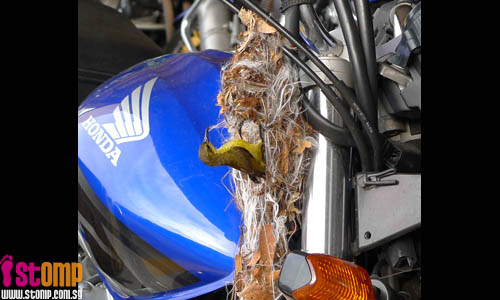

The olive-backed sunbird (Cinnyris jugularis) is also known as the yellow-bellied sunbird, especially in Australia, where it is the only representative of its family. This species is actually Singapore's most common sunbird, and can be commonly found in urban Singapore, so it is quite inaccurate to claim that this is a very rare bird.

Male olive-backed sunbird
(Photo by Lip Kee)
Olive-backed sunbirds are commonly found nesting close to humans; there are numerous accounts of the nesting behaviour of this species over at the Bird Ecology Study Group. When I was living on campus in NTU, there was a pair of nesting olive-backed sunbirds in a tree almost right outside my room. STOMP has older posts showing sunbirds building their nests in gardens, balconies and outside windows. There is also an interesting post about a resident who was distraught upon finding out that a sunbird nest had been removed. In a society that often seems ignorant and oblivious to the existence of other creatures, and seems too willing to eradicate the species which make their presence known, the sight of these tiny, delicate-looking birds nesting so close to humans often serves as a gentle reminder that we share our living space with a multitude of other species.
Sunbirds construct their nests out of twigs, plant fibres and silk from spiderwebs. A hanging nest dangling from a flimsy twig definitely helps to exclude predators such as snakes, squirrels and larger birds, which would find it extremely difficult if not impossible to gain access to the hapless eggs and nestlings.
Going back to the original post, this certainly is a very interesting choice of nest site, and kudos to the staff of Singapore Safety Driving Centre for being able to compromise for the sake of a pair of sunbirds. I hope the sunbirds are able to raise their brood with minimal disturbance.
The male and female are quite different in terms of plumage:
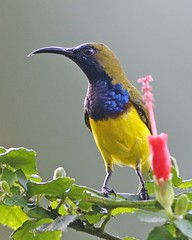
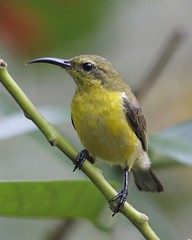
Left: Male olive-backed sunbird;
Right: Female olive-backed sunbird;
(Photos by Lip Kee)
The sunbirds (F. Nectariniidae) are a family of 132 or so species, found in Africa and Asia all the way to New Guinea and northern Australia. Using their long slender bills to sip nectar from flowers, they exploit an ecological niche filled by the hummingbirds (F. Trochilidae) in the New World, although both families are only distantly related to each other. Several members of another unrelated family of birds, the honeyeaters (F. Meliphagidae) of Australia and the Pacific, also share many morphological similarities with sunbirds and hummingbirds due to their nectarivorous lifestyle. Some species of Hawaiian honeycreeper, a subfamily of finches (F. Fringillidae), also bear many similarities to these other small nectar-feeding birds with long and slender bills. It would appear that multiple bird lineages have converged upon the same general body form in order to feed on nectar.
While many sunbird species were classified under the genus Nectarinia in the past, recent research has split off the vast majority of species into separate genera, leaving behind a a small group of about 7 or so African species still in Nectarinia.
The olive-backed sunbird is originally a native of mangroves, but like many other mangrove birds, has adapted very well to Singapore's urban environment. Besides the olive-backed sunbird, Singapore has 8 other resident species of sunbird, along with 3 others that are now locally extinct.
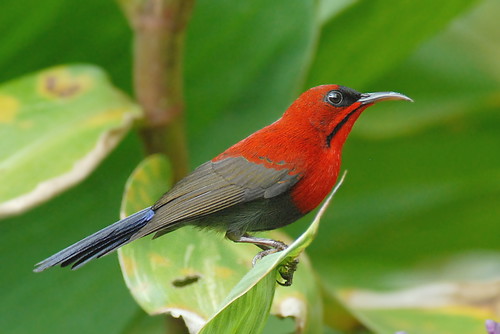
The crimson sunbird (Aethopyga siparaja) is another common species, often encountered in parks, gardens and forests. As an aside, an informal poll in 2002 actually declared the crimson sunbird to be Singapore's national bird.
(Photo by Tiomanese)

The plain-throated sunbird (Anthreptes malacensis) is another commonly encountered species.
(Photo by Lip Kee)

The plain sunbird (Anthreptes simplex) is a rare resident of the forests of the Central Nature Reserves.
(Photo by Ingo Waschkies)

The purple-naped sunbird (Hypogramma hypogrammicum) is found over much of Southeast Asia, but is now locally extinct in Singapore.
(Photo by Ingo Waschkies)
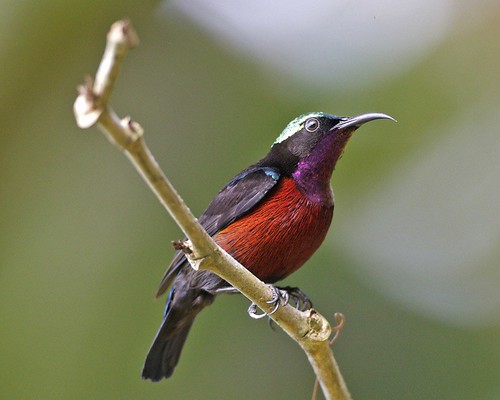
The purple-throated sunbird (Leptocoma sperata) is another widespread species commonly encountered in parks and nature areas.
(Photo by Lip Kee)
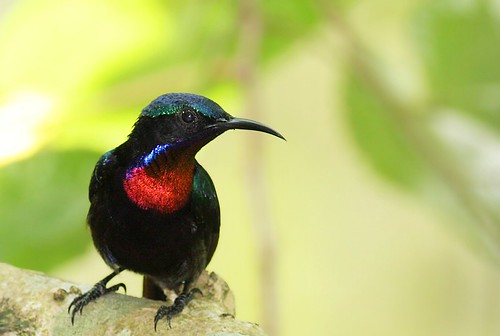
On the other hand, the copper-throated sunbird (Leptocoma calcostetha) is uncommon and restricted to mangrove forests, such as those around Sungei Buloh Wetland Reserve and Chek Jawa.
(Photo by kampang)
The spiderhunters are a group of 11 species of sunbird belonging to the genus Arachnothera, and 5 species have been recorded to occur in Singapore.

The yellow-eared spiderhunter (Arachnothera chrysogenys) is a rare resident, found in the forests of Bukit Timah and Central Catchment Nature Reserve.
(Photo by Ingo Waschkies)
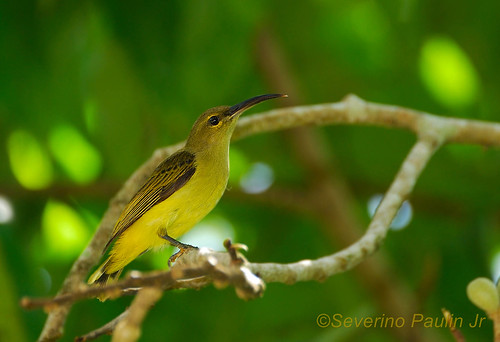
The thick-billed spiderhunter (Arachnothera crassirostris) is similarly restricted to the forests of the Central Nature Reserves.
(Photo by RON PUDIN)

The little spiderhunter (Arachnothera longirostra) is the most widespread and commonly seen spiderhunter, although it is still considered to be uncommon compared to many of the other sunbird species.
(Photo by wokoti)

The grey-breasted spiderhunter (Arachnothera affinis) is another species of sunbird that is now extinct in Singapore.
(Photo by Ingo Waschkies)

The spectacled spiderhunter (Arachnothera flavigaster) is also extinct locally.
(Photo by Ingo Waschkies)
All of our sunbirds, including those which are now extinct in Singapore, are also found in Malaysia, which has a total of 20 sunbird species.
Our more common species of sunbird have definitely greatly benefited from our extensive network of parks and gardens full of flowering plants. I have personally spotted the olive-backed sunbird, crimson sunbird, plain-throated sunbird, purple-throated sunbird and copper-throated sunbird on several occasions. Interestingly enough, Chek Jawa is the only place where I have managed to see all 5 species so far.
The olive-backed sunbird is just one out of several birds that have adapted well to living alongside humans. Hopefully, more of us will be able to look past the crows, mynahs, pigeons and sparrows and see just how much more our urban avifauna has to offer.